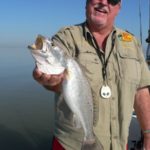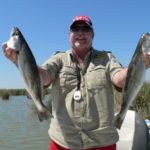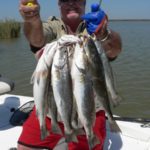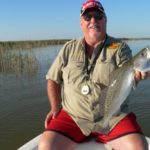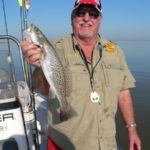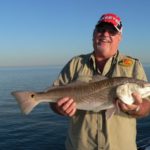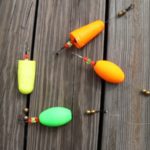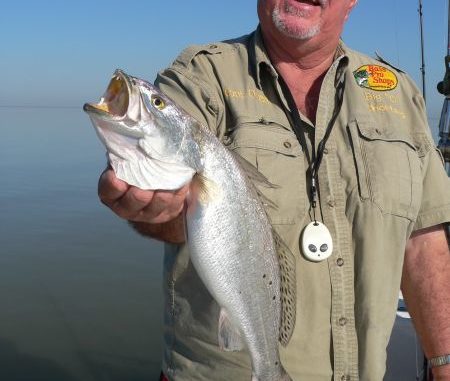
Head to Venice’s outer bays this month for hot trout action.
This is it: You don’t have to wait any longer.
The month we long for with impatient anticipation throughout the entire year has finally arrived in all its spring glory.
Now the weather begins to cooperate; winds lessen and blow good seawater in, tides straighten out, the bays begin to teem with bait and the speckled trout start feeding like piranhas smelling blood.
It’s May in Southeast Louisiana, and the fishing just doesn’t get any better than this.
Charter Capt. Owen “Big O” Langridge (225-978-1136), who has been fishing Venice for some 40 years, is convinced May and June are absolutely his favorite two months of the year for targeting big trout in the area’s big outer bays.
“I look forward to May all year long,” Langridge said. “This is when the trout begin their first major spawn, and they’ll continue spawning from now through the summer.”
That’s an important factor in the fishing frenzy.
“Spawning is a primary instinct that nature instilled to ensure the survival of the species, and these females will spawn every week,” Langridge said. “It’s a rigorous process that causes them to expend an incredible amount of energy, and they replace that energy by voracious feeding.
“That makes this one of the very best times of the year to be on the water, tossing topwater baits or shrimp-imitation lures.”
Langridge recently had a trip scheduled to fish with a couple of his long-time buddies Allen Dessell and Pat Beard, and they willingly agreed to include me on the excursion. We met at daybreak at Venice Marina and loaded our gear aboard Big O’s 24-foot Skeeter Bay boat and headed downriver.
Despite the mid 80s forecast for the day’s temperatures, the river water is still pretty cold and made for a chilly ride downriver. I zipped up my light jacket, and settled in for the 40- to 50-minute ride to our destination: Venice’s big outer bays.
I always thoroughly enjoy fishing out of Venice. It truly is one of the most unique places on earth to fish, located right at the mouth of one of the planet’s largest rivers where it spills into the Gulf of Mexico.
I regret the fact that I don’t get to fish it as much as I’d like, and I mentioned to Langridge that the biggest part of my reluctance is that I just don’t know the waters — and despite GPS technology, not everything is clearly marked on the journey downriver, especially not the treacherous sandbars and flats that love to reach up and snag unwary boaters and strand them aground.
Langridge’s said the solution is obvious.
“There are some of the best, top-quality fishing guides in the country fishing here out of Venice,” he said. “If you’re unfamiliar with the area, hire one. And on the trip, ask questions. We don’t mind answering questions, and the knowledge you’d gain from that trip would be invaluable.”
The be prepared for anything when you show up on your own.
“Make sure you have a good working Marine radio, just in case,” Langridge said. “I’ve been fishing here for 40 years and still don’t know everything I’d like to know about Venice; it’s just so vast.”
How to know where to fish
In an area so vast and with so many options, how do you decide where to fish on a particular day?
Langridge’s answer was simple.
“Wind direction,” he said. “By this time of year our winds will usually come from the east, southeast or south. On a day with a strong east wind, I’ll fish the west side of South Pass, in the East Bay area, or some parts of Garden Island Bay, or the west side of Southwest Pass.
“If the wind is from the southeast or south, I’ll fish the Custom House Bay or Garden Bay areas. Those bays are prime this month.”
The key to success
Langridge says the single-most important key to finding trout this month is finding clean, or at least cleaner, water.
“That’s the challenge,” he said. “And being so close to the outflow of the river, the surface of the water can often look dirty. A casual glance might make you think the water is unfishable, but appearances can really fool you out here. Just beneath the surface there could be some great seawater and hungry trout and redfish.
“You have to check your prop wash to see if any green water is coming up. If it is, then you know there’s clean seawater under the river water, and you can catch fish there.”
Once clean water is found, Langridge searches out bait.
“Dimples, movement, shrimp jumping, anything like that tells me to fish there,” he explained. “I scan the surface way in front of me at points in any of those bays I mentioned, and if it looks promising I approach very slowly and quietly.”
His approach to any area he believes is fishable is vital.
“I kill the outboard at least 75 to 100 yards or more from the point and troll in slow, fishing my way in,” Langridge said. “I watch people roar up to a point with the outboard and throw out their anchor, slamming stuff around in the boat, and then wonder why they can’t catch big trout.
“You might catch a few small ones with that technique, but the big trout don’t live to get big by being stupid. In shallow water loud sounds echo through the hull into the water, and that will send bigger trout scurrying. The old anglers were right when they said you have to be quiet to catch big fish.”
Following his own advice, Langridge dropped the trolling motor far from a nearby point and at low speed we slowly worked towards it. A brief examination of the prop wash had revealed green water underneath the river water, and a pretty good current line moved around the point.
“That current line is another very important factor,” Langridge said. “Bait moves in the current, and the current tends to move strongest around points. Predatory species, like trout and redfish, set themselves around the points to ambush the bait.
“And don’t think the best place to fish is right on the point itself. Unless you’re targeting redfish, you normally want to fish off the point, sometimes by as much as 50 yards. That’s why you start fishing your way in, and when you get a hit, stick it there with your Power Pole or Cajun anchor, and see how many you can put in the boat.”
We were fishing soft plastics about 2 feet under a popping cork, and within a few minutes Langridge hooked a nice trout. The Power Pole went down, and we fished all sides of the boat hoping for a few more and managed a couple more before the action died.
After 10 minutes or so of no bites, he upped the Power Pole and resumed a slow troll toward the point.
We continued that procedure at several nearby points and pockets, and once we got near enough to cast to the point itself, we did so, hoping to entice a hungry redfish. And the reds readily inhaled the same baits.
Langridge said if we were specifically targeting redfish, he’d troll along the shoreline close enough for a long cast to reach the bank, and we’d toss spinner baits (he likes a No. 4 Colorado-bladed spinner and a black/chartreuse H&H cocohoe); gold spoons (he says the Johnson Sprite is hard to beat); shallow-running crank baits like the Baby 1 Minus (the downside is the treble hooks tend to snag in the cane stubble), and the No. 1 redfish bait — live shrimp or market shrimp.
“Whether you believe it or not, live shrimp will outperform market shrimp, and market shrimp will normally outperform everything else,” he said. “And, if you’re using dead shrimp, use the freshest you can get, and unfrozen if possible. I know, the old-timers said to use old stinky dead bait, but fresh will out-fish old and stinky every time.”
Tidal movement is obviously important, and can dictate what Langridge targets.
“I prefer a falling tide for fishing reds because the bait will be coming out of the canes as the tide falls and the reds will be right there, on the edges and even in the canes and cane stubble, waiting to inhale them, so, you’ll want to cast right up to the canes,” he said.
But on the opposite end, he prefers fishing for trout on an incoming tide.
“You can fish successfully on any tide, coming in or going out, as long as you have some movement,” he said. “But I definitely feel like I can do better, catch more trout and bigger trout on an incoming tide.”
This veteran Venice guide also pays close attention to moon phase.
“The week just before and just after the full moon and the new moon are the best of the best,” Langridge said. “That’s because fish instinctively spawn during the strongest tide movements, which takes place just before and after the new and full moon.
“(Trout) eggs are carried by the tide to the Gulf and back to the marsh by the tide, and the fish then feed voraciously. Many people believe the trout spawn on the beaches but actually they’ll spawn anywhere, and then they hunt prey along the beaches and points and reefs and anywhere there’s bait.”
We fished a couple more points and picked up a few fish at each one, repeating the same technique each time.
“The fish are still scattered and not stacked up all in one place just yet, so you might have to move a bit and pick them up a few at a time,” Langridge said. “Just keep doing that, and by the end of the day you’ll have a very respectable box of fish and some nice redfish, too.”
For trout, Langridge prefers shrimp imitation lures: DOAs, H&H, TKO or the Halo Shrimp in his favorite colors of pink or glow/chartreuse, fished about 24 inches under a popping cork.
And for a cork, he likes the Bett’s Lowcountry Lightening corks, the poppers rather than the egg-shaped rattlers. He said the poppers make more noise and move less than the egg-shaped rattling corks.
“Every time you pop the egg-shaped cork you pull that bait closer to you and farther away from the spot where the popping noise originated,” Langridge said. “Think about it: A cork is actually more than a float but also a fish call, and when you pop the cork and drag it toward you, you actually pull it out of the spot where you sent the call. It’s just common sense to me.
“That means the fish are attracted to the spot your bait was, instead of the spot where it is now. You understand?”
There’s another reason why he wants his bait to stay fairly static.
“I believe by dragging it like that you also kill your live shrimp faster on an egg cork over a popper,” Langridge said. “You want to use a popping cork, the kind with the scoop in the top, because it’ll pop and send a call, and stay virtually in the exact same spot.
“I just find them to be more productive.”
Cheap bait also can come back to bite anglers, he said.
“And as far as live bait goes, I believe you should always get it if you can,” Langridge advised. “Live shrimp is absolutely the very best bait there is, and live croakers, too.
“Some folks hate fishing with live bait, and truthfully I prefer using plastics. But I also prefer catching fish to not catching fish, and there are going to be plenty of times when the live stuff will catch fish and the plastics might not.”
Over the course of the day we’d put together a very nice box of trout and several very nice reds, and we settled into the seats for the ride back to the dock.
Langridge said all the big outer bays will hit their prime this month, along with the rigs just out of Custom House Bay about two or three miles out.
So if you love fishing, and catching, this is not the month to sit at home.
Capt. Owen “Big O” Langridge can be reached at (225) 978-1136.
Destination Information
Located at the end of La. Highway 23, Venice is about a 75-mile drive from downtown New Orleans. From downtown, take the Expressway across the Greater New Orleans Mississippi River Bridge and exit at Highway 23 South. Stay on it all the way to Venice.
Marinas
Venice has two first-class, full-service marinas: Venice Marina (504-534-9357), and Cypress Cove Marina (504-534-9289). Both have fuel, ice, bait, backdown ramps, groceries and accessories, a restaurant and lodging.
Guides
Numerous guides operate out of both marinas, offering both inshore and offshore trips. Check the ads in this issue or contact the marinas for more information.
Accommodations
Both marinas offer accommodations, as do some of the guides, and numerous other options are advertised in this issue.
Maps
I haven’t seen any one map cover all of the areas mentioned in this article, so depending on where you intend to fish, one or a combination of these charts might be necessary. Those that cover the areas include Standard Aerial Map Nos. 301, 303 and 343; and Nevalost Map Nos. 1, 2 and 3.
